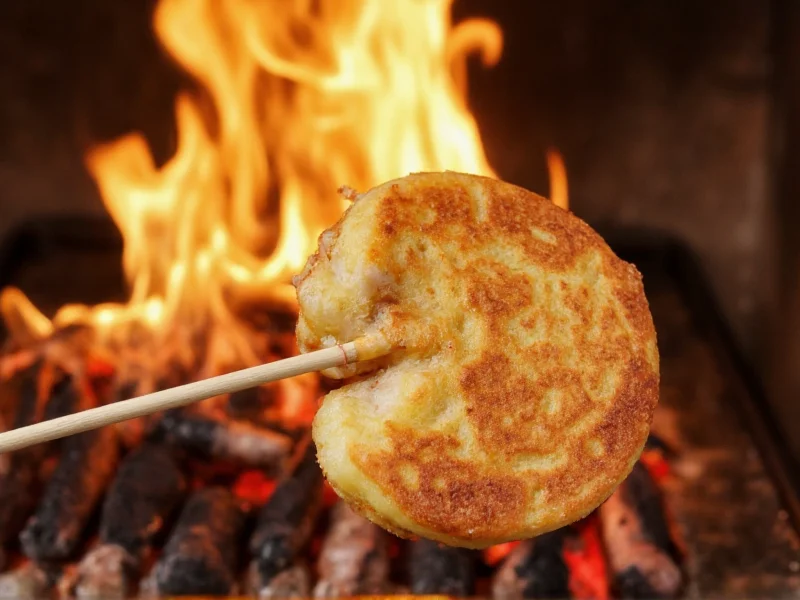Originating from modern culinary creativity rather than a specific cultural tradition, sausage pancake on a stick has gained popularity as a party food and brunch novelty. This innovative dish solves the common breakfast dilemma of messy plates by combining two breakfast staples into one convenient handheld package. Chefs and home cooks alike have embraced this concept for its versatility, ease of preparation, and crowd-pleasing presentation at gatherings.
The Essential Components of Perfect Sausage Pancake Skewers
Creating exceptional sausage pancake on a stick requires attention to both the pancake batter consistency and sausage preparation. The pancake batter must be thick enough to adhere to the sausage but fluid enough to cook evenly around the meat. Meanwhile, the sausage needs proper seasoning and cooking technique to ensure food safety while maintaining juiciness.
| Component | Critical Success Factors | Common Mistakes to Avoid |
|---|---|---|
| Pancake Batter | Medium viscosity (like thick cream), properly rested, balanced leavening | Too thin (runs off), too thick (clumps), overmixed (tough texture) |
| Sausage Preparation | Properly cooked to 160°F, seasoned well, shaped for optimal batter adhesion | Undercooked (safety risk), overcooked (dry), wrong shape (batter slides off) |
| Cooking Technique | Oil temperature control, proper flipping, even browning | Oil too hot (burnt outside, raw inside), inconsistent flipping, overcrowding |
Step-by-Step Preparation Guide
Creating professional-quality sausage pancake on a stick at home requires careful attention to technique. Start by selecting quality breakfast sausage—either pre-made patties you flatten or loose sausage you shape yourself. The ideal sausage diameter should be approximately ¾ inch to ensure proper cooking and batter adhesion.
For the pancake batter, use a standard recipe but adjust for this specific application. The batter should be thicker than typical pourable pancake batter—think of the consistency of muffin batter. This prevents it from sliding off the sausage during cooking. Let the batter rest for 15-20 minutes before use to allow the flour to fully hydrate and the leavening agents to activate.
When assembling, partially cook the sausage first to ensure food safety, then insert a food-safe skewer through the center. Dip the sausage into the batter, rotating to achieve even coverage while leaving about 1 inch of the skewer exposed for handling. The batter layer should be approximately ¼ inch thick for optimal results.
Mastering the Cooking Process
The cooking technique makes or breaks your sausage pancake on a stick. Heat neutral oil (like canola or vegetable oil) to 350-375°F in a deep skillet or pot. Carefully lower the battered sausage into the oil, being mindful of splatter. Fry for 2-3 minutes per side, rotating gently to ensure even browning. The pancake coating should achieve a golden brown color while the sausage reaches a safe internal temperature of 160°F.
Drain excess oil by placing the cooked skewers on a wire rack set over paper towels—this prevents sogginess better than direct paper towel contact. For best texture, serve immediately while the pancake coating remains crisp. If preparing ahead for events, keep finished skewers warm in a 200°F oven on a wire rack, but avoid extended holding times that compromise texture.
Variations and Customization Options
Chefs have developed numerous creative adaptations of the basic sausage pancake on a stick concept. For sweet variations, add cinnamon and vanilla to the batter, then serve with maple syrup for dipping. Savory enthusiasts might incorporate herbs like chives or thyme directly into the pancake mixture. Dietary adaptations include gluten-free versions using rice flour blends and vegetarian options substituting plant-based sausage alternatives.
Professional caterers often create signature versions by injecting flavored syrups into the center of the pancake coating or adding cheese pockets within the sausage. For holiday brunches, miniaturized versions make excellent bite-sized appetizers that guests can easily handle while mingling.
Practical Serving Suggestions
Sausage pancake on a stick shines in casual dining settings and special occasions alike. At brunch gatherings, arrange them upright in a foam block covered with decorative paper for an eye-catching centerpiece. Provide small cups of complementary dipping sauces such as maple syrup, apple compote, or savory gravy. For children's parties, consider creating "breakfast pops" with smaller portions that kids can easily manage.
When planning quantities, allow approximately 2-3 sausage pancake skewers per adult guest for a main course, or 1-2 for appetizer portions. The handheld nature makes them ideal for events where traditional plated breakfast would be impractical, such as outdoor weddings, baby showers, or corporate morning meetings.
Troubleshooting Common Issues
Even experienced cooks encounter challenges with sausage pancake on a stick preparation. If the batter separates from the sausage during cooking, the likely causes are insufficient sausage pre-cooking (so moisture releases during frying) or batter that's too thin. For batter that slides off during assembly, increase the batter thickness slightly and ensure the sausage surface isn't overly greasy.
Burnt exterior with raw interior typically indicates oil temperature that's too high. Use a thermometer to maintain consistent heat, and consider lowering the temperature by 10-15 degrees if this occurs. For soggy results, the oil may have been contaminated with batter bits from previous batches—strain and refresh the oil periodically during large preparations.











 浙公网安备
33010002000092号
浙公网安备
33010002000092号 浙B2-20120091-4
浙B2-20120091-4